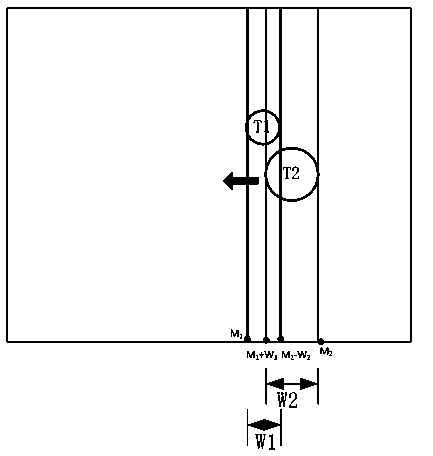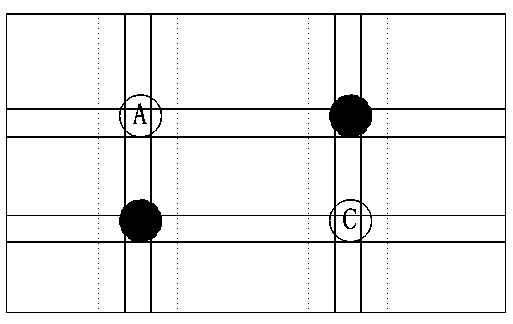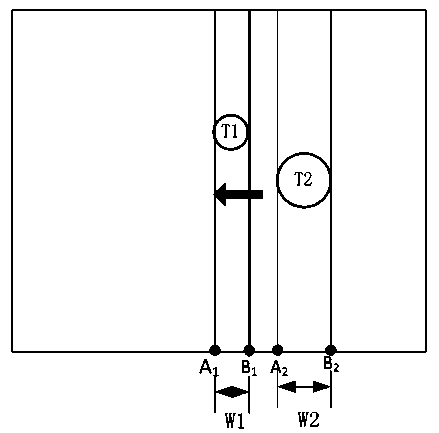Method for improving touch precision of infrared touch screen
An infrared touch screen, high-precision technology, applied in the input/output process of data processing, instruments, electrical digital data processing and other directions, can solve the problem of inability to distinguish, achieve improved touch accuracy, flexible scanning methods, and prevent touch points from jumping. Effect
- Summary
- Abstract
- Description
- Claims
- Application Information
AI Technical Summary
Problems solved by technology
Method used
Image
Examples
Embodiment 1
[0046] This embodiment provides a method for improving the touch accuracy of an infrared touch screen, including the following steps:
[0047] S1: Scan the touch detection area in the horizontal direction, and when the areas covered by the two touch points are independent of each other, obtain the first touch point T in each frame of data 1 The starting boundary A of the occlusion area 1 , the termination boundary B 1 , width W 1 and the second touch point T 2 The starting boundary A of the occlusion area 2 , the termination boundary B 2 and width W 2 ;Such as image 3 As shown, where the first touch point T 1 The width in the horizontal direction is W 1 =B 1 -A 1 ;Second touch point T 2 The width in the horizontal direction is W 1 =B 2 -A 2 ;
[0048] S2: When the respective occluded areas of the two touch points merge into a whole, obtain the starting boundary of the overall occluded area in the horizontal direction in each frame of data as M 1 , the terminat...
Embodiment 2
[0056] On the basis of embodiment 1, the present embodiment makes the following improvements:
[0057] In the step S1, it also includes the step of obtaining the moving direction of each touch point, and the moving direction of the dynamic touch point is represented by an arrow in the figure, where the moving direction of the touching point refers to the direction of the partial velocity of the touching point in the scanning direction , for vertical scanning, the moving direction of the touch point refers to the direction of the component velocity in the vertical direction;
[0058] In the step S2, the steps of obtaining the horizontal start boundary and end boundary of each touch point in each frame of data are as follows:
[0059] Such as Figure 4 As shown, the real-time acquisition of the overall occlusion area in the lateral direction of the initial boundary is M 1 , the termination boundary M 2 And the overall occlusion area width W, W=M 2 -M 1 ;
[0060] There is ...
Embodiment 3
[0067] In this embodiment, on the basis of Embodiment 2, when two touch point occlusion areas meet and then separate, there may be the following two situations:
[0068] If the relative movement direction of the dynamic touch points in the horizontal direction remains unchanged, after the occlusion areas of the two touch points are separated, the order of the two touch points is exchanged, as in Figure 7 As shown, the original second touch point becomes the current first touch point.
[0069] If the relative movement direction of the dynamic touch point changes in the horizontal direction, the order of the two touch points remains unchanged after the occlusion areas of the two touch points are separated, as shown in Figure 9 shown.
[0070] After the above two touch points are separated, obtain the horizontal start boundary, end boundary and width W of the first touch point occlusion area in each frame of data according to the method of step S1 1 and the horizontal start b...
PUM
 Login to View More
Login to View More Abstract
Description
Claims
Application Information
 Login to View More
Login to View More - R&D
- Intellectual Property
- Life Sciences
- Materials
- Tech Scout
- Unparalleled Data Quality
- Higher Quality Content
- 60% Fewer Hallucinations
Browse by: Latest US Patents, China's latest patents, Technical Efficacy Thesaurus, Application Domain, Technology Topic, Popular Technical Reports.
© 2025 PatSnap. All rights reserved.Legal|Privacy policy|Modern Slavery Act Transparency Statement|Sitemap|About US| Contact US: help@patsnap.com



